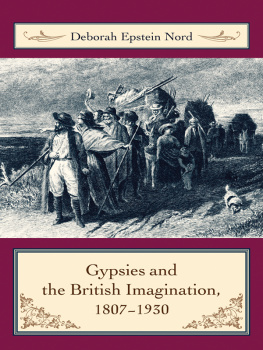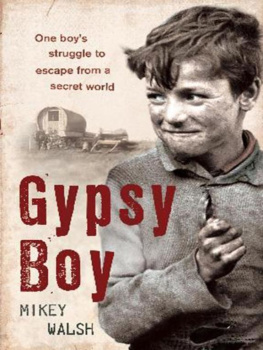Exploring Gypsiness
Exploring Gypsiness
P OWER , E XCHANGE AND I NTERDEPENDENCE IN A
T RANSYLVANIAN V ILLAGE
Ada I. Engebrigtsen
First published in 2007 by
Berghahn Books
www.berghahnbooks.com
First paperback edition published in 2007
Paperback reprinted in 2009
First ebook edition published in 2012
2007, 2009 Ada I. Engebrigtsen
All rights reserved.
Except for the quotation of short passages
for the purposes of criticism and review, no part of this book
may be reproduced in any form or by any means, electronic or
mechanical, including photocopying, recording, or any information
storage and retrieval system now known or to be invented,
without written permission of the publisher.
Library of Congress Cataloging-in-Publication Data
Engebrigtsen, Ada I.
/ Ada I. Engebrigtsen.
p. cm.
Includes bibliographical references and index.
ISBN 978-1-84545-229-2 (alk. paper) -- ISBN 978-1-84545-502-6 (pbk.) -- ISBN 978-0-85745-710-3 (ebk.)
1. Romanies--Romania--Transylvania--Social life and customs. 2. Transylvania (Romania)--Ethnic relations. I. Title.
DX224.E64 2007
305.891'49704984--dc22
2006019282
British Library Cataloguing in Publication Data
A catalogue record for this book is available from the British Library
ISBN 978-1-84545-229-2 hardback
ISBN 978-1-84545-502-6 paperback
ISBN 978-0-85745-710-3 ebook
Preface

My first visit to the hamlet Roma was in April 1993. It was a cold and rainy day and I had just arrived in the village to visit my husband who had spent a month there already. I remember the strange, muddy streets of the village, the horse-drawn wagons driven by men dressed like Brgels peasants in medieval Flanders. The wild-looking, mud-soaked hamlet with its inhabitants all appeared like clichs of Gypsies from my childhoods fairytale books. It seemed another world. We entered the house of Kurva and Joska and found the main room crammed with people of all ages gathered around the TV set with entranced expressions on their faces. Joska and Kurva tore themselves away from the screen with difficulty to perform the prescribed rituals of hospitality, and asked us questions about our well-being and my journey. Then the screen absorbed me too. The film we were all watching was a Romanian cartoon version of The Wonderful Journey of Nils Holgersson by the Swedish author Selma Lagerlf. This story about a small, adventurous village boy in Sweden who jumped up on the back of a migrating goose and followed the flock on its long journey northwards had captured my imagination as a child as it had captured my childrens and was now capturing this audience of Roma of all ages in a muddy hamlet in Transylvania. This experience evoked strong feelings of the psychic unity of mankind and the power of imagination as basic features for the transportation of stories as well as the endeavour of anthropology.
On the last days of my fieldwork in the hamlet in June 1997 Kurva sat down with me on the grass outside her house, sighing with contentment. She had just watched an Indian video (with love and violence kamikaske hai marimaske) for the twentieth time and exclaimed in high spirits: Of all people in the world I like Indians most. They are just like us, they wear their hair and their skirts long and they really know how to dance and play. They have shame just like we have. To me this again very well expresses the power of stories to capture people across different cosmologies, languages and daily lives, but it also reflects what I experienced as the hamlet Romas open-mindedness to imagination and to different life worlds.
Acknowledgements
First I would like to emphasise the importance of the the work of previous Gypsy researchers in the U.S.A. and in Europe for my understanding of the Rom/villager relationship in Transylvania. The work of Judith Okely on Travellers in Britain (1983), of Patrick Williams on Rom and Manouches in France (1985, 1993) and of Michael Stewart on Roma in Hungary (1997) have played particularly important roles in my own analysis
Next I would like to express my debt to the people of the village and hamlet. I can never pay back the warm and emotionally fulfilling experience of laughing, joking and sometimes crying in overcrowded and overheated Rom houses and in more densely populated and somewhat under-heated Romanian kitchens. Neither can I pay back the intellectual stimulation of participating in peoples lives and writing about it afterwards. I can only thank the Roma and Romanians in the village and hamlet for receiving us with warmth and enthusiasm and for sharing their food, space and company with us. All the names used in this book are my inventions, in order to preserve my informants anonymity.
I want to thank my husband Lars Gjerde, for conducting fieldwork with me in Romania, as an interpreter and a colleague. I believe our co-operation doubled the scope of my observations and enriched my analysis. His transcribed tape recordings from our fieldwork have been part of my data and some have been presented in my text. I also thank him for endlessly reading through chapters of this book, for his analytical suggestiveness, for his criticism and for his praise. I also want to extend my gratitude to Mr Viorel Achim for receiving Lars Gjerde and myself at his Buchare

ti office and discussing his work with us, and for his helpful reply to my e-mails. I thank Michael Stewart, who is, in his way, responsible for this book by encouraging me to rewrite my thesis, for his support.
I want to thank Signe Howell and many of my colleagues at the Department of Anthropology who have read parts of this book. A special thanks to Benedicte Brgger and Axel Borchgrevink, together with Anne Waldrop and Elisabeth Lorange Frst, who have read and commented on several chapters and given me valuable feedback.
Equal thanks go to Norwegian Social Research, NOVA and Norsk faglitterr forfatter- og oversetterforening, NFF, for financial support. A special thank you to my colleague at NOVA Kirsten Danielsen for reading the manuscript and suggesting necessary changes. Thanks to my friend Aurora Kanbar, who corrected the Romanian text, and to Lars Gjerde for the Romanes text, and to Marion Berghahn for her support and patience.
And last but not least I send warm thoughts to Mona Mrtl for her courage, humour and stamina and for making the village and hamlet accessible to us.













 ti office and discussing his work with us, and for his helpful reply to my e-mails. I thank Michael Stewart, who is, in his way, responsible for this book by encouraging me to rewrite my thesis, for his support.
ti office and discussing his work with us, and for his helpful reply to my e-mails. I thank Michael Stewart, who is, in his way, responsible for this book by encouraging me to rewrite my thesis, for his support.